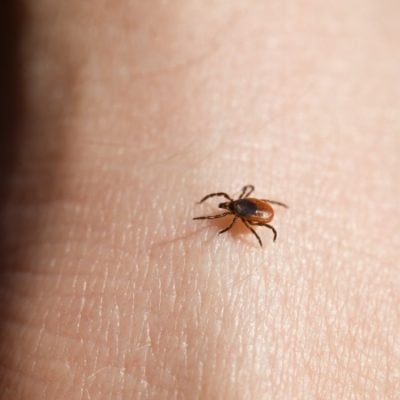
Thousands of East End natives live with Lyme disease. Meet the doctors working to treat them.
LJ pulled a tick from under her arm, at the bra line, eight years ago. The next day, she had a horrible “flu,” a slight fever and headache. “I felt every organ in my body shift when I rolled over in bed,” she said. A week later, a bullseye rash, called an “ erythema migrans” (EM) appeared, a classic sign of Lyme disease. LJ went to a walk-in clinic and was prescribed two weeks of doxycycline. “At the end of the day I couldn’t talk,” she said. “The words were in my head but I couldn’t get them from my brain out of my mouth.” The muscles on the left side of her face weakened, while the right side tingled. She could not walk a straight line but got herself to the emergency room. A stroke code was called. An MRI revealed not a stroke but eight lesions on her brain. A lumbar puncture found “nondescript proteins” in her spinal fluid. Results for Lyme disease were negative. “I showed the doctor the ring on my side,” she said. “It was bright as day.” “Nope,” the neurologist told her. “The two have nothing to do with each other. Lyme doesn’t do this.” She was pulled off antibiotics and diagnosed with multiple sclerosis (MS) that day. She left the hospital after three days and spent the next three months in bed. “I was unable to lift my head off the pillow,” she said. “I had two small children and my husband was getting pissed.” Her husband, a working partner in three East End restaurants, was bit by a tick that summer. He was not treated. After a flu shot that fall, he couldn’t walk. “It was similar to what I had, walking into walls, but worse,” she said. “His whole body shook, his liver and kidneys were failing.” The mother moved her kids out of their home, leaving no rock unturned. “It was a neurological poison of some sort, or so it seemed,” LJ said. An array of environmental specialists tore the house apart looking for environmental toxins. Her husband had his own team of specialists. Like LJ, her husband’s Lyme tests showed some evidence of past infection but not enough antibodies to meet the Center for Disease Control’s (CDC) criteria for a positive Lyme result. He, too, came away with an MS diagnosis. He had 32 lesions. “His brain was Swiss cheese,” LJ said. “He spent eight weeks in a hospital re-learning how to walk and talk. He had to train his whole body all over again, like he was an infant.” Over time, their health made improvements. Their marriage did not. They continued to work as a family unit under duress. LJ’s knee was an ongoing issue. “After my knee replacement three years ago, my body went haywire,” she said. That year, she had 17 urinary tract infections, a high viral load, heart problems and was plagued with yeast. Five different doctors requested AIDS tests even though every test was negative. All the while, LJ couldn’t get the EM rash out of her mind. She sensed her symptoms were due to Lyme, not MS. Thousands of dollars and many tests later, she was still hopeless. “I felt like I was losing control of my body. I couldn’t remember how to turn on the sink,” she said. “God forbid someone tried to talk to me while I tried to turn on the sink. I’d bite their head off.” Oddly enough, her friend in upstate New York was presenting with similar symptoms. Her Lyme results were also CDC negative, however, her friend was clinically diagnosed with Lyme by her primary care physician and was being treated by a “Lyme-literate” doctor in Mount Kisco, New York. Dr. Daniel Cameron, a former president of the International Lyme and Associated Diseases Society (ILADS) has been treating Lyme patients for over 25 years. His science-based blog, “ All Things Lyme,” helps to explain the disease to patients, caregivers and doctors, “when they’re ready.” His suggestion for anyone who is bit by a tick? “Do a little homework, even if they’re not sick.” The bacteria, a slow-growing, stealth infection, can bore itself into every cell and negatively affect every organ and system in the body. It loves the bladder, brain and bone marrow, joints, heart, thyroid and pancreas. It has the ability to hide from the immune system. Depending on the doctor, antibiotic course length varies from one to 28 days, the maximum treatment for Lyme, as per the Infectious Disease Society of America (IDSA) guidelines, woefully outdated, according to the National Guidelines Clearinghouse. Complicating matters, Lyme treatment can create a “ Herxheimer” reaction, when endotoxins are released into the blood stream, making the patient sicker. “Too many people find it frustrating when they don’t get better after a three-week course of antibiotics,” Dr. Cameron says. “If someone doesn’t get better, they are surprised.” The CDC makes it clear that Lyme should be clinically diagnosed, but too many doctors rely on the standard two-tier testing, which measures antibody response to the infection, not the infection itself, and is notoriously faulty. The first tier, an “enzyme-linked immunosorbent assay” (ELISA) or “enzyme immunoassay” (EIA) has a 50-percent false negative rate. The CDC recommends giving the second tier, a Western Blot (WB) only if the first is positive. In order for the WB to be “positive” there must be five-out-of-10 positive bands on the IgG section and three-out-of-five on the IgM section of the test. Most patients only see the CDC result, not the whole WB test. This can be misleading because it is possible that only one positive band could mean you have Lyme. China requires only one positive band. In Virginia and Maryland, if a patient’s test comes back negative, by law, they must tell the patient, “That doesn’t mean you don’t have Lyme.” Dr. Richard Horowitz, a Lyme-literate physician in Hyde Park, New York, explains Lyme symptoms and diagnoses, including how to interpret the different bands on a WB, in his book Why Can’t I Get Better? If a person is still sick after treatment, they are usually diagnosed with conditions such as rheumatoid arthritis, fibromyalgia, chronic fatigue syndrome, Lupus, depression, irritable bowel syndrome, Alzheimer’s, ALS or MS. Each person has different genes and stresses and each tick has a different set of pathogens when it meets its host. “Lyme is a complicated illness,” Dr. Cameron says. “There are different types of infections in the same tick.” Common co-infections, such as Babesia, a blood parasite similar to malaria, do not respond to doxycycline. Studies have shown that 40 percent of people with Lyme also have Babesia, also found in our blood supply. Other tick-borne illnesses found in the U.S. include Alpha-gal (mammalian meat allergy) Anaplasmosis, Bartonella, Ehrlichia, Mycoplasma and Rickettsias, like Rocky Mountain Spotted Fever and relapsing tick fever. Although rare, the deadly Powassan virus should not be overlooked. “Fatigue, sleep disturbances, poor concentration, head pressure, light-headedness, tingling, irritability, joint pain and sweats, are just some of the more commonly missed symptoms,” says Dr. Cameron. The best way to prevent illness, is to treat as soon as possible after a tick bite. “It’s better to overtreat than undertreat,” says Gerald Simons, PA-C. Simons, along with Dr. Joseph Burrascano started the ILADS doctor training program on Springs Fireplace Road in East Hampton. Decades ago, Dr. Burrascano treated Lyme patients from all over the world and was featured in the movie, Under Our Skin. He no longer practices medicine, yet many still consider his protocols, using longer courses of antibiotics, important in treating Lyme. Simons sees patients at Dr. George Dempsey’s office in East Hampton and “makes guests appearances” at the Morrison Center in Manhattan, where he is having good results with Low Dose Naltrexone, Low Dose Allergen and Low Dose Immunotherapy and suggests herbs like teasel root and cat’s claw to help keep Lyme in check. He noted that magnesium, calcium and potassium, interact with antibiotics. “Take those supplements away from antibiotics,” Simons says. Antibiotics were invented for infections like Lyme, not for the common cold or to be pumped into our food supply. Yet, unlike teenage acne, there is a stigma when it comes to longer-term antibiotic use when treating Lyme. The bacteria has never become immune to antibiotics but it is very good at shielding itself from antibiotics and other treatment forms. Lyme is a shapeshifter, and will form biofilms to protect itself, according to Dr. Eva Sapi‘s work at the University of New Haven. Some Lyme-literate doctors “pulse” treatments in an attempt to “fool” the bacteria. Dr. Alan MacDonald, a former Southampton Hospital pathologist, who has worked with Dr. Sapi, began his research using the model for syphilis, Lyme’s spirochetal cousin. Like syphilis, Lyme can be sexually transmitted and passed from mother to child in utero. Like syphilis, Lyme mimics over 300 other conditions. Dr. MacDonald found Lyme in nine out of 10 Alzheimer’s brains from the Harvard brain bank, as well as in a baby with two holes in the heart. The CDC noted three young adults died suddenly from Lyme carditis in the Northeast in 2014. I have a feeling there are many more deaths due to Lyme than the CDC lists. Remember, Lyme numbers jumped tenfold to 300,000 nationwide in one year. Young people are walking around with new hearts, hips and knees, or one less gallbladder, thyroid or lymph node. I wonder how many invasive surgeries could have been prevented if Lyme was caught and treated early? “There’s tremendous need,” for better diagnostics, says Dr. Benjamin Luft. He and his team at Stony Brook University have sequenced the genomes of 22 strains of Borrelia burgdorferi (Bb), the first known bacteria to cause Lyme disease. Studying Bb’s big family tree is proving to be helpful in developing a more sensitive test as well as preventing Lyme. A new OspA vaccine is “in phase II trials.” Dr. Luft hopes to avoid the calamity of Lymerix. The first Lyme vaccine caused chronic Lyme disease in people who already had OspA, a protein found in the mid-gut of ticks, in their systems. “The previous vaccine had certain parts that were cross-reactive to human proteins,” Luft says. “We took those regions of the protein out, hopefully circumventing the problem of cross-reactivity.” “Without a doubt, tick-borne illnesses are a public health crisis,” says Suffolk County Legislator Bridget Fleming. “It’s hard to find someone not affected by one of these devastating diseases.” “We’ve spent millions of dollars on open space, but people are afraid to go outside,” says Fleming. “Our natural resources are the engine that runs our economy. We want to make sure people are out there in the wilderness.” Fleming cites Dr. Scott Campbell’s position as head of the Suffolk County Tick Control Advisory Committee, the appointment of entomologist Moses Cucura, of Suffolk County Vector Control, to the Tick Surveillance and Management Program, and new equipment for the Arthropod-borne Disease Program Lab, which Scott also heads, as ways the county has stepped up their game. “ Suffolk County is poised to become a leader in tick-borne diseases,” says Fleming. “By understanding the complicated landscape of ticks and their hosts, how these diseases are getting into humans, and start to intervene.” While Fleming waits for her funding proposal to the legislators to come through, New York Senator Kirsten Gillibrand championed a bill in the U.S. Senate, “Lyme and Tick-Borne Disease Prevention, Education, and Research Act.” Key provisions of the bill became law as part of the 21st Century Cures Act that Congress passed, and former President Obama signed into law in December 2016. The Secretary of Health and Human Services is required to establish a federal Tick-Borne Diseases Working Group, which will be tasked with improving federal efforts to combat Lyme and other tick-borne diseases. If things go according to plan, researchers, healthcare providers and patient organizations will coordinate with federal agencies and every two years, the working group will submit a report regarding recommendations. “These new provisions passed into law last year will help ensure that patient voices are represented in conversations at the federal level so we can improve the work the government is doing to address Lyme and other tick-borne diseases,” Gillibrand says. “I will do everything I can to make sure that these new provisions are enacted as Congress intended so that we can make progress in the fight against Lyme disease.” In the meantime, patients are turning underground; to stem cells treatment in India, Mexico and Panama, Rife frequency generators, ozone therapy, hyperbaric oxygen chambers, milk fasts, bee venom therapy, complicated herbal protocols, supplement regimens, mega doses of anthelmintics and months-long, inpatient medical centers. None of the treatments guarantees a cure, remission or relief. They are not approved by the Federal Drug Administration, nor are they covered by insurance. Costs are astronomical all around, yet very little research is being done. Global Lyme Alliance, a Lyme advocacy group based out Connecticut, funds much of today’s research. Closer to home, Southampton Hospital Lyme and Tick-borne Disease Resource Center, raises public awareness by hosting educational events and handing out free tick removal kits. Just ask Karen Wulffraat, Community Outreach Coordinator for one. Have a question? Call Rebecca Young, RN, BSN, at 631-726-TICK. The center does not treat Lyme. Untreated, or undertreated, Lyme can contribute to autoimmune disease and some cancers. For a harrowing yet inspiring Lyme journey, read oncologist Dr. Neil Spector’s Gone in a Heartbeat: A Physician’s Search for True Healing .” Read the entire article on Edible East End.






